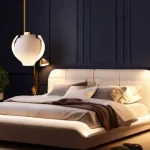Welcome to the world of smart bedroom lighting! If you’ve ever dreamed of a bedroom that adapts to your mood, enhances your sleep, or simply makes life a bit easier, smart lighting is the way to go.
Imagine walking into a room where the lights gently brighten to greet you, or where you can adjust the ambiance with a simple voice command. Sounds pretty amazing, right?
We’ll explore the different types of smart lighting solutions available, discuss their benefits, and share design ideas to help you modernize your bedroom. Whether you’re a tech enthusiast or just looking to improve your space, you’re in the right place!
What to Know About Smart Lighting
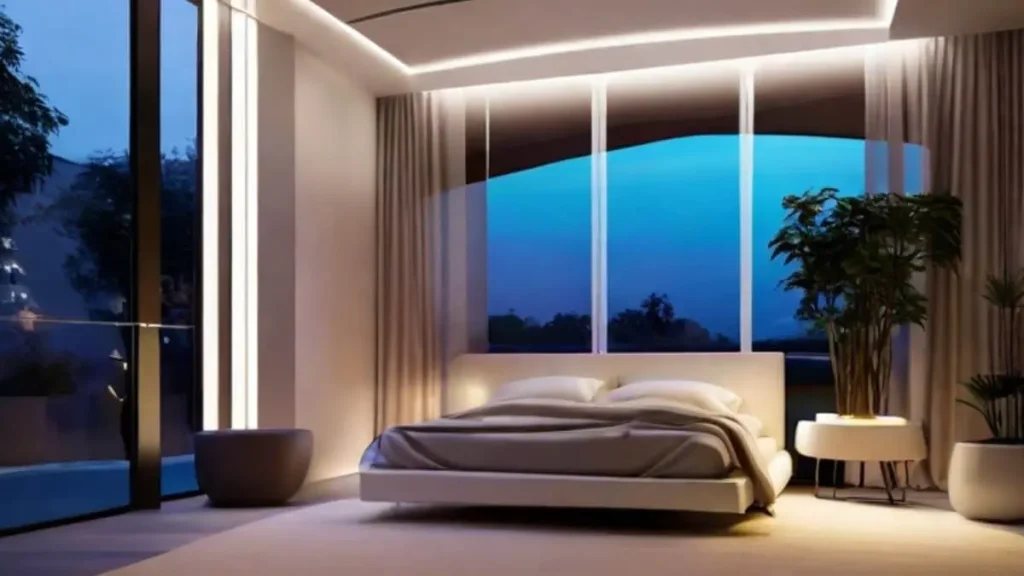
What is Smart Lighting?
Smart lighting isn’t just about having fancy light bulbs; it’s about creating a lighting experience that fits your lifestyle. Unlike traditional lighting, smart lighting systems connect to your home’s Wi-Fi network, allowing you to control them with your smartphone, tablet, or voice commands. This means you can adjust the brightness, change colors, or even set schedules without ever leaving your bed!
Types of Smart Lighting
- Smart Bulbs: These are the most popular type of smart lighting. You can screw them into your existing light fixtures and control them through an app or voice assistant. Imagine being able to change your bedroom’s lighting from bright and energizing to soft and cozy, all with a few taps on your phone. Brands like Philips Hue and LIFX offer a range of colors and brightness levels to suit any mood or occasion.
- Smart Light Strips: Perfect for adding a touch of flair, smart light strips can be placed under your bed, behind furniture, or along walls. They’re great for creating ambient lighting or adding a splash of color to your decor. For instance, you might use a light strip to add a warm glow to the edge of your bed frame, making your space feel more inviting.
- Smart Lamps: If you prefer something more traditional but with a high-tech twist, smart lamps are a great option. These lamps come with built-in smart features and can be controlled just like smart bulbs. They’re perfect for bedside tables or desks, offering both style and functionality.
- Smart Light Panels: For those who love a bit of design innovation, smart light panels offer customizable lighting effects. You can arrange these panels in various patterns on your walls to create unique lighting designs. Some panels even sync with music or other smart devices, making them a fun addition to any bedroom.
- Smart Plugs: If you have non-smart lights that you love, you can still bring them into the smart world with smart plugs. These plugs allow you to control regular lamps and fixtures via your smartphone or voice assistant, adding a bit of smart functionality without replacing your existing lights.
With these smart lighting solutions, you can transform your bedroom into a dynamic and personalized space. Next, we’ll delve into the benefits of smart lighting and how it can enhance your bedroom experience.
Benefits of Smart Lighting in the Bedroom
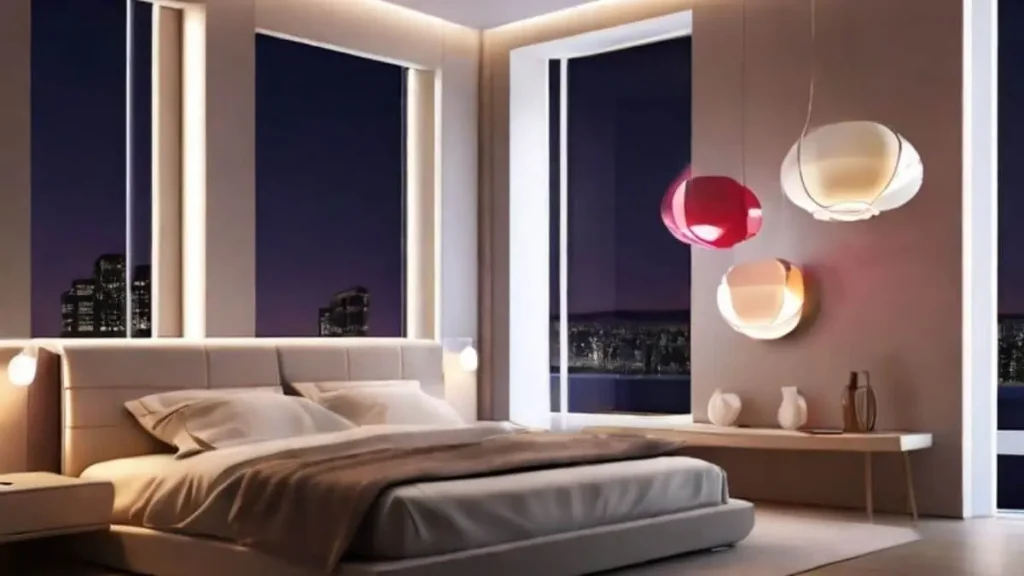
Enhanced Ambiance and Mood Control
One of the biggest perks of smart bedroom lighting is its ability to set the perfect mood. Imagine coming home after a long day and being greeted by a soft, warm glow that instantly relaxes you.
With smart lighting, you can create just the right atmosphere for any occasion. For instance, use cooler, brighter lights for your morning routine to energize you, and switch to warmer, dimmer lights for a cozy, relaxing evening.
You can even program your lights to change gradually, mimicking a sunrise to wake you up gently.
Energy Efficiency
Smart lighting isn’t just stylish—it’s also practical. By switching to smart bulbs and fixtures, you can significantly cut down on your energy use. Many smart bulbs are LED-based, which means they use less electricity and last longer than traditional incandescent bulbs.
Plus, with features like scheduling and remote control, you can ensure that lights are only on when you need them. For example, you can set your lights to turn off automatically when you leave for work or adjust their brightness based on the time of day.
Convenience and Control
Gone are the days of fumbling for the light switch in the dark. With smart bedroom lighting, you have the convenience of controlling your lights from anywhere.
Whether you’re in bed, at work, or even on vacation, you can adjust your lighting settings from your smartphone or tablet. Voice control adds another layer of convenience—just ask Alexa, Google Assistant, or Siri to turn your lights on or off, change the color, or set the mood.
Improved Sleep Quality
Good lighting plays a crucial role in regulating your sleep patterns. Smart lighting can help you create a sleep-friendly environment by simulating natural light cycles. For example, you can use smart bulbs to gradually dim your lights in the evening, signaling to your body that it’s time to wind down.
In the morning, a gentle, gradual increase in light can help wake you up more naturally, setting you up for a better day.
Recommended: Why Lighting Matters in Creating a Cozy Bedroom
Smart Lighting Design Ideas for Modern Bedrooms
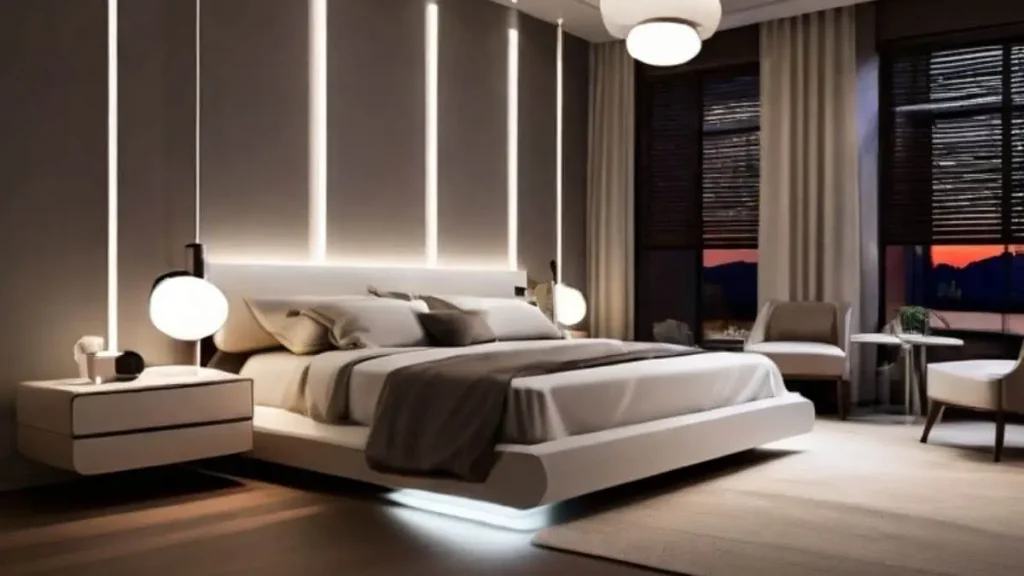
Accent Lighting for a Modern Touch
Smart lighting can add a stylish flair to your bedroom decor. Use smart light strips to highlight architectural features or create a glowing effect behind your bed. For instance, placing light strips along the back of your headboard can create a dramatic, floating effect that adds depth and sophistication to your room.
Similarly, smart spotlights can be used to draw attention to artwork or other focal points in your bedroom.
Mood Lighting with Color-Changing Bulbs
Color-changing smart bulbs offer endless possibilities for creating different moods in your bedroom. Want a calming atmosphere for reading or relaxing? Opt for soft blues or greens. Planning a cozy movie night?
Switch to warm amber tones. Many smart bulbs allow you to choose from millions of colors, so you can easily match your lighting to your room’s decor or your mood.
For example, a vibrant red can energize your space for a lively gathering, while soothing pastels can provide a serene environment for unwinding.
Layered Lighting Techniques
Achieving a well-lit, modern bedroom involves combining different types of lighting to create a balanced effect. Start with ambient lighting, such as a ceiling fixture or overhead light, to provide overall illumination.
Then, add task lighting with bedside lamps or reading lights to ensure you have adequate light for specific activities. Finally, incorporate accent lighting to highlight certain features or add visual interest.
Layering these lighting types allows you to adjust your bedroom’s ambiance according to your needs, from a bright and functional workspace to a soft and relaxing retreat.
Smart Lighting for Small Spaces
If your bedroom is on the smaller side, smart lighting can help you make the most of your space. Opt for sleek, minimalist designs that don’t overwhelm the room.
Smart light panels or compact smart bulbs can provide effective lighting without taking up too much visual space. Consider using light strips to create the illusion of a larger room by highlighting architectural elements or adding depth to the space.
For instance, placing light strips along the top of the walls can make the room feel taller and more open.
With these smart lighting ideas, you can not only enhance the functionality of your bedroom but also elevate its style and atmosphere.
Installation and Setup Tips for Smart Lighting
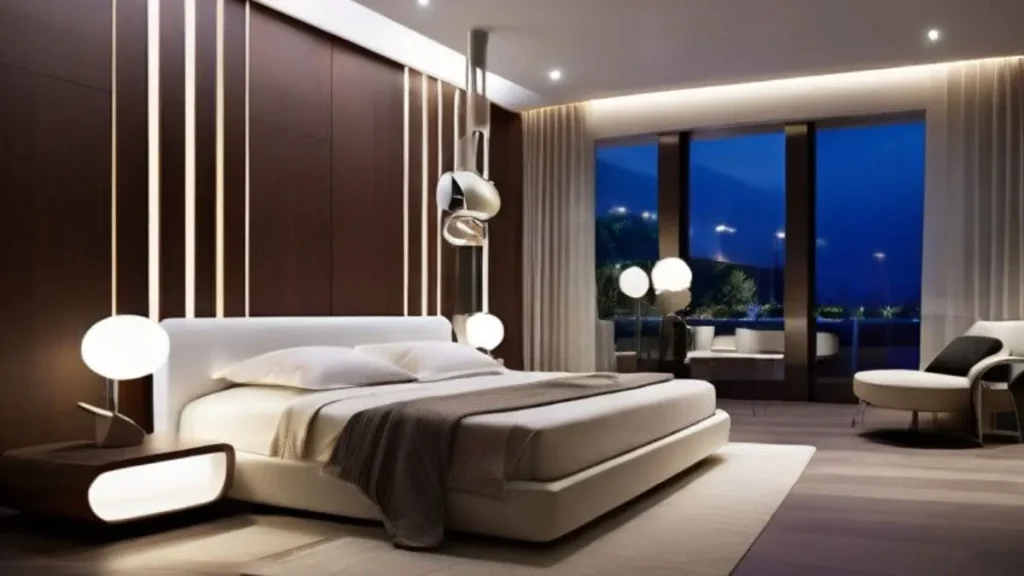
Choosing the Right Smart Lighting System
When selecting a smart lighting system, consider compatibility with your existing home setup. Most smart lighting solutions work with popular voice assistants like Alexa, Google Assistant, and Apple HomeKit.
Ensure that the smart lighting products you choose are compatible with these systems or any smart home hub you already have. Additionally, consider factors like ease of installation, user reviews, and your budget.
Brands like Philips Hue, LIFX, and Nanoleaf offer a range of options to fit various needs and preferences.
Installation Best Practices
- Smart Bulbs: Installing smart bulbs is straightforward. Simply replace your current bulbs with smart ones, screw them into the light fixtures, and follow the manufacturer’s instructions for connecting them to your home Wi-Fi network. Most smart bulbs come with a companion app that guides you through the setup process.
- Smart Light Strips: Light strips can be a bit more involved. Measure the area where you want to place them, cut the strips to size (if needed), and attach them using the adhesive backing. Ensure that you connect the strips to the power source and follow the app instructions to configure them. Light strips can be installed behind furniture, along baseboards, or even on ceilings for a stunning effect.
- Smart Lamps: For smart lamps, the setup usually involves plugging them in and following the app’s setup instructions. Many smart lamps come with built-in connectivity, so you’ll only need to link them to your home network and configure the settings through the app.
- Smart Light Panels: Light panels require some assembly. Arrange the panels according to your desired design, attach them to the wall using the included adhesive strips or mounting hardware, and connect them to the power source. Follow the app instructions to connect the panels to your Wi-Fi network and adjust the settings.
Troubleshooting Common Issues
If you encounter issues with your smart lighting, here are a few tips to troubleshoot common problems:
- Connectivity Issues: Ensure that your smart lighting device is within range of your Wi-Fi network. If you’re having trouble connecting, try restarting your router or reconfiguring the device through the app.
- App Malfunctions: Make sure you’re using the latest version of the app. If the app isn’t responding, try reinstalling it or checking for updates.
- Unresponsive Devices: Power cycle the smart lighting device by turning it off and on again. If the problem persists, check the manufacturer’s website or support resources for additional help.
Integrating Smart Lighting with Other Smart Home Features
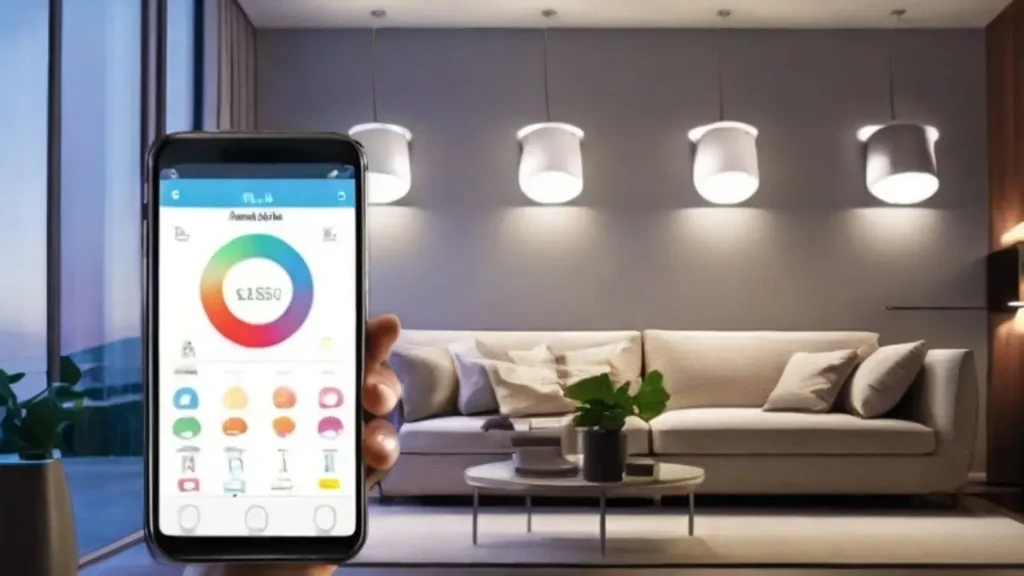
Syncing Smart Lighting with Music or Entertainment Systems
One of the exciting features of smart lighting is its ability to sync with your music or entertainment system. Many smart lighting systems offer music sync modes that adjust the lighting to match the beat and rhythm of your favorite tunes.
For example, you can set your smart lights to pulse in time with the music during a party or create a relaxing, cinematic ambiance when watching a movie.
To set this up, ensure your smart lighting system supports music synchronization and follow the instructions in the app or on the product’s support page.
Using Smart Lighting with Smart Thermostats
Integrating smart lighting with a smart thermostat can enhance your comfort and energy efficiency. For instance, you can create routines where your lights and thermostat work together.
Set your lights to turn on and your thermostat to adjust the temperature as soon as you arrive home. Similarly, program your lights to dim and your thermostat to lower the temperature in the evening to help you unwind.
This kind of integration can be managed through smart home hubs or automation apps that support multiple smart devices.
Voice Command Integration
Voice command integration makes controlling your smart lighting effortless. By connecting your smart lighting system to voice assistants like Amazon Alexa, Google Assistant, or Apple HomeKit, you can manage your lights with simple voice commands.
For example, you can say, “Alexa, set the bedroom lights to reading mode,” or “Hey Google, turn off the lights.” This hands-free control adds a layer of convenience and makes it easy to adjust your lighting without having to find your phone or use a physical switch.
Integrating smart lighting with other smart home features, you can create a seamless and efficient living environment.
Smart Lighting Safety and Maintenance Tips
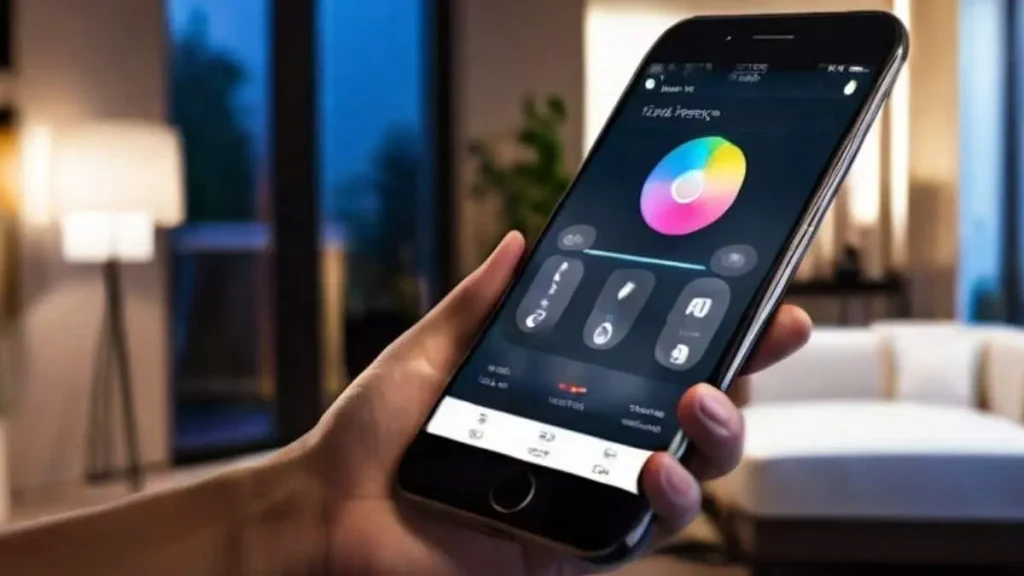
Ensuring Electrical Safety
When installing smart lighting, safety should always be a priority. Here are a few tips to keep in mind:
- Follow Manufacturer Instructions: Always adhere to the installation and usage guidelines provided by the manufacturer. This helps prevent accidents and ensures proper functionality.
- Check Electrical Compatibility: Make sure that your electrical system is compatible with the smart lighting products you choose. If you’re unsure, consult an electrician.
- Avoid Overloading Circuits: Don’t exceed the recommended wattage for your light fixtures. Overloading can lead to overheating and potential hazards.
- Regular Inspections: Periodically check the connections and components of your smart lighting system to ensure they are secure and in good condition.
Maintaining Smart Lighting Systems
Keeping your smart lighting system in good shape involves a few simple maintenance tasks:
- Clean Smart Devices Regularly: Dust and debris can accumulate on smart bulbs, lamps, and light strips. Gently clean them with a soft, dry cloth to keep them looking their best and functioning properly.
- Update Firmware: Manufacturers often release firmware updates to improve performance and add new features. Check for updates in your smart lighting app and install them as needed.
- Check Battery Levels: For smart lamps and other battery-operated devices, monitor and replace batteries as needed to ensure continuous operation.
- Inspect and Replace Worn Components: If you notice any issues with your smart lighting, such as flickering lights or connectivity problems, inspect the components and replace any worn or damaged parts.
Backup Options in Case of Power Outages
Smart lighting systems rely on a stable power supply and internet connection. To manage power outages or connectivity issues:
- Use Smart Plugs with Backup Power: Consider using smart plugs with battery backup for critical smart lighting devices. This can help ensure that your lights stay functional during short power outages.
- Manual Overrides: Many smart lights come with manual controls or physical switches. Familiarize yourself with these options so you can still operate your lights if the smart system fails.
Conclusion
Smart bedroom lighting is more than just a trend; it’s a practical and stylish way to enhance your living space. By understanding the various types of smart lighting solutions, their benefits, and how to integrate them with other smart home features, you can create a bedroom that’s not only beautiful but also highly functional.
From setting the perfect mood to improving energy efficiency and convenience, smart lighting offers numerous advantages that can transform your bedroom experience.
With the right installation, maintenance, and integration, you can enjoy the full benefits of smart lighting while ensuring safety and longevity.
Ready to modernize your bedroom with smart lighting? Whether you’re looking to add a touch of elegance, improve functionality, or simply enjoy the latest in home technology, smart lighting is the way to go. Dive into the world of smart lighting and start enjoying a brighter, more personalized living space today!



